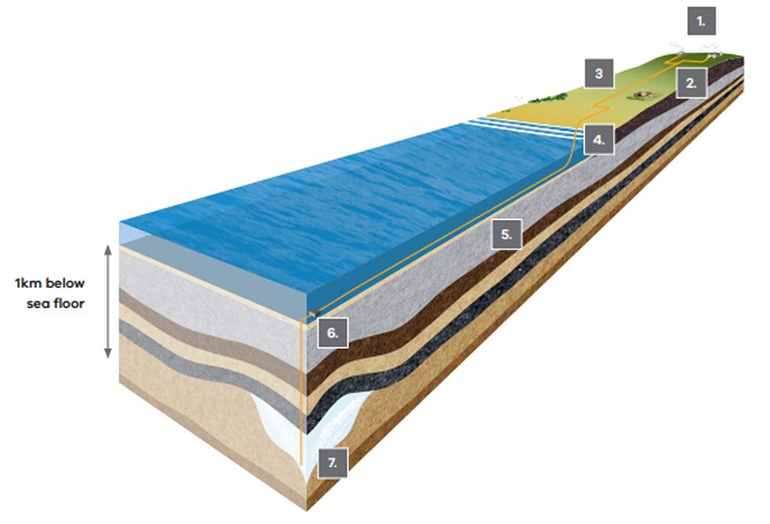About the CarbonNet Project
Funded by the Victorian and Australian Governments and established in 2009, the purpose of the CarbonNet project is to establish a commercial‑scale CCS network in Gippsland that will enable new and existing decarbonised industries to contribute to Victoria’s 2035 interim emissions reduction target and a net zero emissions outcome by 2045. Delivery of CarbonNet will be beneficial for the Gippsland region where jobs and investment will occur as a direct result of this project.
Project Scope
CarbonNet manages, and is investing in, two separate offshore storage sites - Pelican and Kookaburra.
Pelican
The Pelican storage site is located approximately 10km offshore in the Gippsland Basin. To validate the Pelican site, the project team analysed existing subsurface data, together with rock core material and information from over 50 existing wells within the immediate project area. Then in late 2019, CarbonNet successfully drilled an Australian-first offshore appraisal well for CCS to obtain further data on the Pelican site, including formation fluids and sub-surface core samples. The samples have allowed CarbonNet to validate the properties of the storage reservoir and cap rock which will trap the stored CO₂ in place.
- Located in Bass Strait 1.5km beneath the seabed
- At least 168 million tonnes capacity at P90 @ 6 million tonnes per year
- Projected operational lifespan of 30 years
- One of the potential development options for the Pelican Storage site is a 100km pipeline from Loy Yang to Golden Beach enabling multiple CO₂ industrial capture projects based in the Latrobe Valley. The pipeline will consist of approximately 80km of buried onshore pipeline and a further 20km (approximate) of offshore pipeline, reaching two drill centres located at CarbonNet’s Pelican Site.
A graphical representation of the Pelican concept is shown below.
Kookaburra
Located approximately 25km offshore in a water depth of 46m, Kookaburra targets formations below the now depleted Perch oil field which ceased production operations in 2019. The site is a structural trap within the top Latrobe Group with the seal being the Lakes Entrance Formation. The Perch field is currently in the process of being decommissioned.
- Located in Bass Strait 1.5km beneath the seabed
- At least 188 million tonnes capacity at P90 @ 7.5 million tonnes per year
- Projected operational lifespan of 25 years
- Kookaburra will potentially service an international CO₂ market utilising an offshore Floating Storage and Injection Unit.
Project timeline
- Declaration of Storage Formation for both Pelican and Kookaburra in 2026
- Project operational late 2030s, pending approvals and development partner being in place.
Project progress
CarbonNet has completed extensive investigations which have been subject to independent review and certification, including detailed modelling of potential CO2 storage sites in Bass Strait.
The project is currently in Stage Three - Project Development and Commercial Establishment.
- Regulatory approvals will commence - Environment Effects Statement referral (Vic) and Environment Protection and Biodiversity Conservation referral.
- Front-Engineering Design (FEED) completed.
- Front-Engineering Design (FEED).
- Pipeline Consultation Plan approved.
- Preparation for regulatory approvals, FEED and DoS.
- Offshore Appraisal Well and analysis of geology.
- Regulatory and environmental approvals achieved, and ongoing.
- Stakeholder and community engagement taking place and ongoing.
- Request for Industry Submissions (RFIS).
- Geophysical and Geotechnical surveys conducted in preparation of the drilling the Offshore Appraisal Well.
- Extensive stakeholder and community engagement ongoing.
- A marine seismic survey in February 2018 provided additional geological information about Pelican.
- The Victorian and Australian Governments agreed to progress CarbonNet to Stage 3 – Project Development and Commercial Establishment.
The Pelican concept

The above image is representative of the Earth’s layers with multiple levels of rock. It shows an example of a reservoir used to store carbon dioxide 1km below the Earth’s surface.
The surface layer is split into an onshore component and an offshore component. The onshore component displays an illustration of a capture site, connection point and an onshore pipeline. The offshore component displays an illustration of an offshore pipeline and a geological storage reservoir.
Multiple elements are labelled which match up with the described elements in the Projects elements description table.
Project elements description
| Label Number | Project Element | Description |
|---|---|---|
| 1. | Customer Capture Sites (Not CarbonNet owned or operated) | Customer capture sites will provide captured and compressed CO2 to CarbonNet for transportation and storage at Pelican. Potential industries include, but are not limited to, hydrogen, fertiliser and bioenergy. |
| 2. | Gateway Connection Point | A gateway connection point will be located at Loy Yang in the Latrobe Valley, enabling multiple planned or operating projects to connect into the CO2 transportation and storage network. Loy Yang is therefore the proposed start point for the CO2 transport pipeline. |
| 3. | Onshore Pipeline | Approximately 80km of 400mm* pipeline will run from Loy Yang to the shoreline crossing at Golden Beach. *Diameter to be confirmed during Front End Engineering Design. |
| 4. | Shoreline Crossing | The pipeline will cross the shoreline likely using a horizontal directional drilling (or similar) technique, to avoid direct impacts on sensitive coastal features. The pipeline will emerge 1km offshore. |
| 5. | Offshore Pipeline | Approximately 20km of pipeline will be laid directly on the seafloor, depending on the local design requirements, to the subsea injection location at Pelican. |
| 6. | Offshore injection and monitoring wells | It is envisaged that Pelican will include up to six injection wells (including monitoring systems) distributed across two drill centres, with possible additional monitoring wells. |
| 7. | Geological CO2 storage reservoir – Pelican | Capacity of up to six Mtpa over 30 years and storage of compressed CO2 within the Pelican structure modelled for permanent containment. |
Page last updated: 23 September 2025
